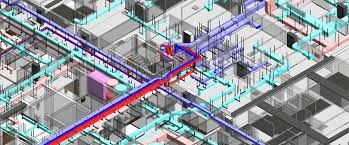In the ever-evolving landscape of construction and building management, the integration of technology plays a pivotal role in enhancing efficiency, sustainability, and performance. Mechanical, Electrical, and Plumbing (MEP) services form the backbone of any building, encompassing crucial systems that ensure functionality and comfort. As we venture into the future, several emerging technologies are poised to revolutionize MEP services, offering innovative solutions to age-old challenges while aligning with the industry's increasing emphasis on sustainability and efficiency.
Building Information Modeling
Building Information Modeling (BIM) has already made significant strides in revolutionizing the way buildings are designed, constructed, and managed. However, its integration with MEP services is set to deepen further, offering comprehensive digital representations of building systems. Digital twins, virtual replicas of physical assets, enable real-time monitoring, simulation, and analysis of MEP systems, facilitating predictive maintenance and optimization. With the integration of IoT sensors and data analytics, digital twins empower building managers to make informed decisions, enhance energy efficiency, and minimize downtime.
Advanced HVAC Systems
Heating, Ventilation, and Air Conditioning systems are integral components of MEP services, contributing significantly to building comfort and energy consumption. Emerging technologies are reshaping HVAC systems, emphasizing energy efficiency, sustainability, and occupant well-being. Innovations such as variable refrigerant flow (VRF) systems, which offer precise control over temperature and zoning, and advanced filtration technologies to improve indoor air quality, are gaining prominence. Additionally, the integration of machine learning algorithms enables HVAC systems to adapt dynamically to changing environmental conditions, optimizing performance while reducing energy consumption.
Smart Building Automation
The proliferation of IoT devices and interconnected systems has paved the way for smart building automation, transforming traditional MEP services into intelligent, responsive ecosystems. Smart sensors, actuators, and controllers enable centralized monitoring and control of MEP systems, enhancing operational efficiency and occupant comfort. Automated building management systems leverage real-time data to optimize energy usage, predict equipment failures, and streamline maintenance workflows. Furthermore, the integration of Artificial Intelligence (AI) algorithms enables predictive analytics, enabling proactive decision-making and optimization of MEP services.
Renewable Energy Integration
As sustainability becomes increasingly paramount in the construction industry, the integration of renewable energy sources into MEP services is gaining momentum. Solar photovoltaic (PV) panels, wind turbines, and geothermal heat pumps offer viable alternatives to traditional energy sources, reducing carbon emissions and dependency on fossil fuels. Advancements in energy storage technologies, such as lithium-ion batteries and hydrogen fuel cells, facilitate the effective integration of intermittent renewable energy sources into building infrastructure. By harnessing renewable energy, buildings can achieve greater energy independence and resilience while contributing to global efforts to combat climate change.
Augmented Reality and Virtual Reality Applications
AR and VR technologies are revolutionizing the way MEP services are designed, installed, and maintained, offering immersive and interactive experiences for stakeholders. Designers can visualize MEP systems in situ, facilitating collaboration and identifying potential clashes during the design phase. During construction, AR-based applications overlay digital MEP models onto physical spaces, guiding installers and ensuring accurate implementation. Moreover, VR simulations enable training and skill development for maintenance personnel, enhancing safety and proficiency in servicing MEP systems.
3D Printing and Prefabrication
The adoption of 3D printing and prefabrication techniques is streamlining the manufacturing and installation of MEP components, reducing costs and construction timelines. Customizable ductwork, piping, and electrical conduits can be fabricated off-site using 3D printing technology, ensuring precision and minimizing waste. Prefabricated MEP modules, assembled in controlled factory environments, can be seamlessly integrated into building structures, reducing on-site labor and disruption. These innovative manufacturing approaches enhance project efficiency while maintaining quality standards in MEP installations.
Conclusion
As the construction industry embraces the digital revolution, the future of MEP services looks increasingly promising, driven by a convergence of emerging technologies. From advanced building information modeling and smart automation to renewable energy integration and immersive AR/VR applications, the landscape of MEP services is evolving to meet the demands of a rapidly changing world. By embracing these innovations, stakeholders can unlock new opportunities for efficiency, sustainability, and performance in building design, construction, and management, ultimately shaping the future of the built environment for generations to come.


No comments yet